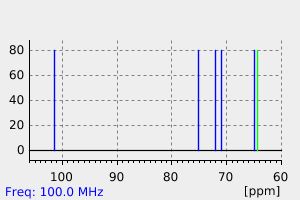1,6-内醚-D-半乳糖 | 644-76-8
中文名称
1,6-内醚-D-半乳糖
中文别名
1,6-脱水-BETA-D-半乳糖
英文名称
1,6-anhydro-β-D-galactopyranose
英文别名
galactosan;D-anhydrogalactose;1,6-Anhydro-beta-d-galactopyranose;(1R,2R,3S,4R,5R)-6,8-dioxabicyclo[3.2.1]octane-2,3,4-triol
CAS
644-76-8
化学式
C6H10O5
mdl
——
分子量
162.142
InChiKey
TWNIBLMWSKIRAT-FPRJBGLDSA-N
BEILSTEIN
——
EINECS
——
-
物化性质
-
计算性质
-
ADMET
-
安全信息
-
SDS
-
制备方法与用途
-
上下游信息
-
文献信息
-
表征谱图
-
同类化合物
-
相关功能分类
-
相关结构分类
物化性质
-
熔点:226 C
-
沸点:383.8±42.0 °C(Predicted)
-
密度:1.688±0.06 g/cm3(Predicted)
-
溶解度:甲醇(微溶)、水(微溶)
计算性质
-
辛醇/水分配系数(LogP):-2.1
-
重原子数:11
-
可旋转键数:0
-
环数:2.0
-
sp3杂化的碳原子比例:1.0
-
拓扑面积:79.2
-
氢给体数:3
-
氢受体数:5
安全信息
-
危险品标志:Xn
-
安全说明:S26,S36
-
危险类别码:R20/21/22
-
海关编码:29400000
SDS
上下游信息
-
上游原料
中文名称 英文名称 CAS号 化学式 分子量 β-半乳糖苷酶 β-D-galactopyranoside 7296-64-2 C6H12O6 180.158 D-吡喃葡萄糖 D-Galactose 10257-28-0 C6H12O6 180.158 β-乳糖 LACTOSE 5965-66-2 C12H22O11 342.3 1,-脱水-3,-O-异丙二烯-β-D-谷氨酸五乙酸酯 1,6-anhydro-3,4-O-isopropylidene-β-D-galactopyranose 52579-97-2 C9H14O5 202.207 —— 1,6-anhydro-β-D-galactopyranose 125164-19-4 C18H28O8 372.416 2,3,4,6-O-四乙酰基-D-半乳糖 2,3,4,6-tetra-O-acetyl-α/β-D-galactopyranose 47339-09-3 C14H20O10 348.307 2,3,4-三(苄氧基)-6,8-二氧杂双环[3.2.1]辛烷 1,6-anhydro-2,3,4-tri-O-benzyl-β-D-galactopyranose 29704-64-1 C27H28O5 432.516 beta-D-半乳糖五乙酸酯 β-D-galactose peracetate 4163-60-4 C16H22O11 390.344 1,2,3,4,6-戊-O-乙酰-a-D-吡喃半乳糖 penta-O-acetyl-α-D-galactopyranose 4163-59-1 C16H22O11 390.344 苯基-beta-D-吡喃半乳糖苷 phenyl-β-D-galactopyranoside 2818-58-8 C12H16O6 256.255 -
下游产品
中文名称 英文名称 CAS号 化学式 分子量 —— (D)-anhydrogulose 14274-90-9 C6H10O5 162.142 1,-脱水-3,-O-异丙二烯-β-D-谷氨酸五乙酸酯 1,6-anhydro-3,4-O-isopropylidene-β-D-galactopyranose 52579-97-2 C9H14O5 202.207 —— 1,6-anhydro-2-O-butanoyl-β-D-galactopyranose 128333-93-7 C10H16O6 232.233 —— 1,5-Anhydro-β-D-lyxopentofuranose 51246-93-6 C5H8O4 132.116 —— 1,6-anhydro-2,3-di-O-butanoyl-β-D-galactopyranose 128333-89-1 C14H22O7 302.324 —— 1,6-anhydro-2,4-di-O-butanoyl-β-D-galactopyranose 128333-90-4 C14H22O7 302.324 —— 1,6-anhydro-β-D-galactopyranose 125164-19-4 C18H28O8 372.416 —— 1,6-anhydro-2-O-benzyl-β-D-galactopyranose 116836-98-7 C13H16O5 252.267 —— 3-O-(Methanesulfonyl)-1,6-anhydro-beta-D-galactopyranoside 1452154-23-2 C7H12O7S 240.234 —— 4-(Triethylsiloxy)-1,6-anhydro-beta-D-galactopyranoside 1452154-12-9 C12H24O5Si 276.405 2,3,4-三(苄氧基)-6,8-二氧杂双环[3.2.1]辛烷 1,6-anhydro-2,3,4-tri-O-benzyl-β-D-galactopyranose 29704-64-1 C27H28O5 432.516 1,2,3,4,6-D-葡萄糖五乙酸酯 D-galactose pentaacetate 25878-60-8 C16H22O11 390.344 —— 1,6-anhydro-β-D-galactose 1452154-09-4 C12H24O5Si 276.405 —— 4-O-(Methanesulfonyl)-1,6-anhydro-beta-D-galactopyranoside 1452154-26-5 C7H12O7S 240.234 —— O2-methanesulfonyl-1,6-anhydro-β-D-galactopyranose 52526-54-2 C7H12O7S 240.234 —— 1,6-anhydro-3,4-O-(S)-benzylidene-β-D-galactopyranose 71021-25-5 C13H14O5 250.251 —— endo-1,6-anhydro-2-O-benzyl-3,4-O-(2-naphthyl)methylene-β-D-galactopyranose 502690-07-5 C24H22O5 390.436 —— 1,6-anhydro-3,4-O-isopropylidene-β-D-lyxo-hexopyranos-2-ulose 17073-94-8 C9H12O5 200.191 - 1
- 2
反应信息
-
作为反应物:描述:参考文献:名称:Micheel, Chemische Berichte, 1929, vol. 62, p. 687,692摘要:DOI:
-
作为产物:描述:β-半乳糖苷酶 360.0 ℃ 、13.33 Pa 条件下, 生成 1,6-内醚-D-半乳糖参考文献:名称:Micheel, Chemische Berichte, 1929, vol. 62, p. 687,692摘要:DOI:
文献信息
-
Regio- and Stereochemical Controlled Koenigs-Knorr-Type Monoglycosylation of Secondary Hydroxy Groups in Carbohydrates Utilizing the High Site Recognition Ability of Organotin Catalysts作者:Wataru Muramatsu、Hirofumi YoshimatsuDOI:10.1002/adsc.201300414日期:2013.9.16and stereoselective monoglycosylation of carbohydrates using organotin catalysts is demonstrated. The one‐step reaction affords various oligosaccharides linked at the secondary hydroxy group in high chemical yield and good regio‐ and stereoselectivities. The regioselectivity of the glycosylation is shown to depend on the spatial arrangement of the hydroxy groups in the carbohydrates.
-
Catalyst recognition of cis-1,2-diols enables site-selective functionalization of complex molecules作者:Xixi Sun、Hyelee Lee、Sunggi Lee、Kian L. TanDOI:10.1038/nchem.1726日期:2013.9Carbohydrates and natural products serve essential roles in nature, and also provide core scaffolds for pharmaceutical agents and vaccines. However, the inherent complexity of these molecules imposes significant synthetic hurdles for their selective functionalization and derivatization. Nature has, in part, addressed these issues by employing enzymes that are able to orient and activate substrates within a chiral pocket, which increases dramatically both the rate and selectivity of organic transformations. In this article we show that similar proximity effects can be utilized in the context of synthetic catalysts to achieve general and predictable site-selective functionalization of complex molecules. Unlike enzymes, our catalysts apply a single reversible covalent bond to recognize and bind to specific functional group displays within substrates. By combining this unique binding selectivity and asymmetric catalysis, we are able to modify the less reactive axial positions within monosaccharides and natural products. The manipulation of complex molecules offers an avenue for developing new therapeutics and biological probes. Here, a catalyst is described that forms a covalent bond to the substrate before selectively functionalizing a proximal functional group. Cis-1,2-diols are targeted allowing for the derivatization of the axial hydroxyls of monosaccharides in the presence of unprotected equatorial hydroxyls.碳水化合物和天然产物在自然界中扮演着重要角色,并为制药剂和疫苗提供了核心骨架。然而,这些分子的固有复杂性给其选择性功能化和衍生化带来了重大的合成挑战。自然界在一定程度上通过利用酶来解决这些问题,这些酶能够在手性口袋中定向和激活底物,从而显著提高有机转化的速率和选择性。本文展示了,在合成催化剂的情境下,类似的接近效应也可以被利用来实现复杂分子的一般性和可预测的位点选择性功能化。与酶不同,我们的催化剂采用单一的可逆共价键来识别和结合底物中的特定功能基团。通过结合这种独特的结合选择性和不对称催化,我们能够修饰单糖和天然产品中较不活跃的轴向位置。复杂分子的操作为开发新的治疗药物和生物探针提供了途径。这里描述了一种催化剂,它在与底物形成共价键后,选择性地功能化邻近的功能基团。目标为顺-1,2-二醇,允许在未保护的赤道羟基存在下衍生化单糖的轴向羟基。
-
Tin-Mediated Regioselective Benzylation and Allylation of Polyols: Applicability of a Catalytic Approach Under Solvent-Free Conditions作者:Maddalena Giordano、Alfonso IadonisiDOI:10.1021/jo402399n日期:2014.1.3The first catalytic version of the stannylene-mediated benzylation and allylation of polyols is reported. The methodology is based on a simple solvent-free protocol that significantly advances, in terms of both experimental ease and synthetic scope, the applicability of tin-promoted selective protections. The described approach is indeed endowed with a very large number of advantages over routine protocols:报道了由亚苯乙烯介导的多元醇的苄基化和烯丙基化的第一个催化形式。该方法基于简单的无溶剂方案,在实验简便性和合成范围方面,都大大提高了锡促进的选择性保护的适用性。与常规方案相比,所描述的方法确实具有许多优点:使用低催化负载量的廉价Bu 2SnO是避免使用溶剂的一步法工艺,是在空气中进行反应的最低要求的实验程序,缩短了反应时间,简化了后处理工艺,目标范围广,在许多情况下,收率均优于常规协议。另外,无催化溶剂的方法将亚锡烷基化学的范围扩展到了空前的应用领域,以还原糖和合成高苄基化的结构单元,而这些过程可以通过更苛刻的程序来获得。从概念的角度来看,所描述的结果表明,无溶剂条件可以帮助开发催化方法,否则该方法在溶液中无效。
-
Selective Catalytic Oxidation of Unprotected Carbohydrates作者:Kevin Chung、Robert M. WaymouthDOI:10.1021/acscatal.6b01501日期:2016.7.1in trifluorethanol, but for pyranosides bearing axial substituents at C2 or C4, selective oxidation to the 3-ketose is accompanied by epimerization to afford the equatorial 3-ketoses. Catalytic oxidation of unprotected hexafuranosides or sialic acid derivatives occurs selectively at the exocyclic diol or triol in trifluoroethanol to generate exocyclic hydroxyketones.对未保护的碳水化合物进行直接催化功能化的新策略的开发将是糖科学的一个有利的进展。在本文中,我们报道了未保护的碳水化合物的催化氧化可以选择性地与[[neocuproine)Pd(OAc)] 2(OTf)2(1)进行,以生成3-酮糖。在酚类添加剂存在下,Pd含量低至1%即可进行催化好氧氧化。使用Pd催化剂1催化乙腈或乙腈/水中的各种未保护吡喃糖苷的催化氧化1用氧气或苯醌选择性地生成3-酮糖。少量的4-酮糖竞争性地形成,特别是在吡喃糖苷在吡喃糖苷的C4处带有轴向取代基的情况下。催化氧化也可以在三氟乙醇中进行,但是对于在C2或C4处带有轴向取代基的吡喃糖苷,选择性氧化成3-酮糖伴随着差向异构化作用,得到了赤道的3-酮糖。未保护的六呋喃糖苷或唾液酸衍生物的催化氧化选择性地在三氟乙醇中的环外二醇或三醇处发生,以生成环外羟基酮。
-
Regioselective Alkylation of Carbohydrate Derivatives Catalyzed by a Diarylborinic Acid Derivative作者:Lina Chan、Mark S. TaylorDOI:10.1021/ol200990e日期:2011.6.17Regioselective, catalyst-controlled monoalkylations of cis-vicinal diol motifs in carbohydrate derivatives, using a diphenylborinic ester precatalyst, are described. Selective installation of benzyl, naphthylmethyl, 4-bromobenzyl and benzyloxymethyl protective groups at a single secondary hydroxy group of ten representative carbohydrate derivatives illustrates the scope of this method. This new mode
表征谱图
-
氢谱1HNMR
-
质谱MS
-
碳谱13CNMR
-
红外IR
-
拉曼Raman
-
峰位数据
-
峰位匹配
-
表征信息
同类化合物
(双(2,2,2-三氯乙基))
(2-氧杂双环[4.1.0]庚烷-7-羧酸乙酯
高壮观霉素
香芹酮氧化物
雷公藤甲素
雷公藤内酯酮
雷公藤内酯三醇
雷公藤乙素
钴啉醇酰胺,Co-(氰基-kC)-,磷酸(酯),内盐,3'-酯和(5,6-二甲基-1-a-D-呋喃核糖基-1H-苯并咪唑-2-胺-2-14C-kN3)(9CI)二氢
钠甲醛2-羟基苯磺酸酯4-(4-羟基苯基)磺酰苯酚
醛固酮21-乙酸酯
醛固酮18,21-二乙酸酯
醋酸泼尼松龙环氧
醋酸氟轻松杂质
螺[1,3-二氧戊环-2,2'-[7]氧杂双环[4.1.0]庚烷]
苯甲酸,4-[3-(三氟甲基)-3H-重氮基丙因-3-基]-,2,5-二羰基-1-吡咯烷基酯
芳香松香
芍药苷代谢素 I
索迪叮
盐(9CI)二氢4H-吡咯并[3,2-d]嘧啶-4-酮,7-[(2S,3S,4R,5R)-3,4-二羟基-5-[(磷羧基氧代)甲基]-2-吡咯烷基]-1,5--,二铵
甲基[(1R,2S,4R,6S)-4-羟基-1-甲基-7-氧杂双环[4.1.0]庚-2-基]乙酸酯
甲基(1S,2S,5R)-1-乙氧基-2-甲基-3-氧杂双环[3.2.0]庚烷-2-羧酸酯
环龙胆四糖全乙酸酯
环氧环己基环四硅氧烷
环氧己烷
泼尼松龙环氧
氧杂环庚-4-酮
氧化环己烯
氧化异佛尔酮
氟米龙杂质
柠檬烯-1 2-环氧化物
景天庚酮糖
明奈德
戊哌醇
强心-4,16,20(22)-三烯交酯,7,8-环氧-11,14-二羟基-12-羰基-2,3-[[(2S,3S,4S,6R)-四氢-3-羟基-4-甲氧基-6-甲基-2H-吡喃-3,2-二基]二(氧代)]-,(2a,3b,7b,11a)-(9CI)
布地奈德杂质15
己二酸,二(4-甲基-7-氧杂二环[4.1.0]庚-3-基)酯
娄地青霉
多纹素
外-顺-7-氧杂二环<2.2.1>庚-5-烯-2,3-二甲醇碳酸酯
吡啶,1,2-二氢-4,5,6-三甲基-2-亚甲基-(9CI)
吡咯烷,1-(2-哌嗪基羰基)-(9CI)
台湾牛奶菜双氧甾甙 B
反式-1,2-环氧-4-叔丁基环己烷
反式-1,2-环氧-4-叔丁基环己烷
双((3,4-环氧环己基)甲基)己二酸酯
去环氧-脱氧雪腐镰刀菌烯醇
卡烯内酯甙
半短裸藻毒素B
十二氟-1,2-环氧环庚烷







